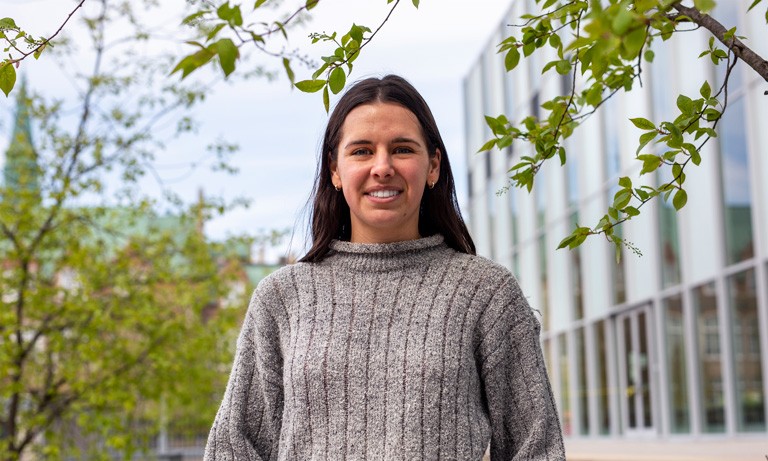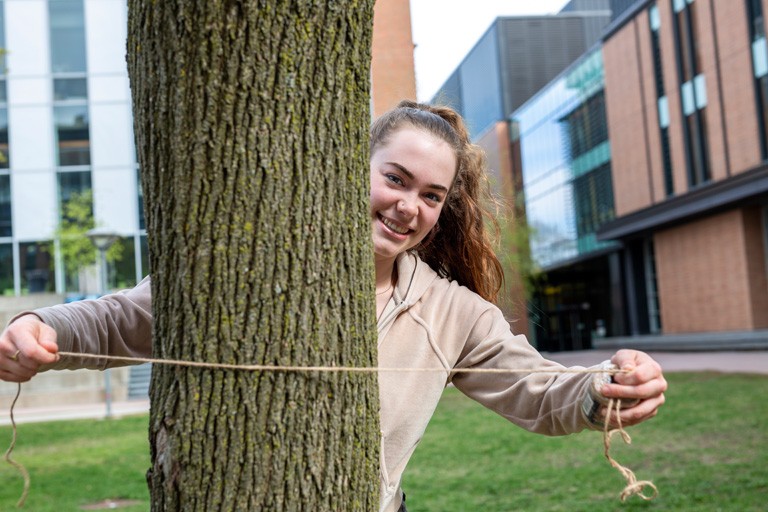A new Concordia research project is inviting residents of Montreal's Notre-Dame-de-Grâce neighbourhood to explore and document urban trees - right in their own backyard.
Using a method that allows participants to learn something while getting fresh air, the NDG Tree Project is led by Carly Ziter, assistant professor of biology in the Faculty of Arts and Science.
"Montreal is fortunate to have an excellent public tree inventory, but many of the city's trees are actually located on private land, and we know very little about them. This means our understanding of the urban forest is like a puzzle with half the pieces missing," says Ziter.
Ziter is a member of the CERC Smart Sustainable Resilient Cities and Communities team.
Her contribution to the CERC team is to highlight the essential role of urban green space and biodiversity in creating a next-generation city. Ziter's work finds nature-based solutions to ensure the health and well-being of urban residents.
 Kayleigh Hutt-Taylor: "Finding new ways to engage the public has been an exciting challenge for me."
Kayleigh Hutt-Taylor: "Finding new ways to engage the public has been an exciting challenge for me." Making sense of our urban 'patchwork'
"Our cities are like patchwork quilts - made up of bits and pieces of built infrastructure and different kinds of green spaces. Private yards make up a really important - and really big! - piece of that ecological fabric," she says.
With this in mind, Ziter and her MSc student Kayleigh Hutt-Taylor created a project to map trees on private land around Concordia's Loyola Campus.
Initially, the project would have involved Ziter and her students - known as the "tree team" - visiting participants' homes to measure and document the species of the owners' trees.
But the COVID-19 pandemic meant the project had to change gears.
The result? A do-it-yourself approach that allows participants to measure trees themselves, using basic tools that include string or twine, a notebook or downloadable worksheet, and a camera or smartphone.
"This project speaks to the university's strong commitment to sustainability," says Concordia President Graham Carr.
"The fact that our researchers were able to adapt it to our current situation is an example of our community's resilience and ingenuity. I hope many of our Loyola neighbours will take this opportunity to get outside and learn about the trees in our own backyards."
 Maya Catterall's passion for trees and how they support life in urban centres led her to seek out the project.
Maya Catterall's passion for trees and how they support life in urban centres led her to seek out the project.'Citizen science'
"We decided to take a 'citizen science' approach, asking residents to participate in data collection for their own yards," Ziter explains.
"At its heart, scientific research is often about creative problem-solving, and I think this is a good example of that creativity in action," she adds. "Now that we've made the switch, I'm actually really excited about the potential of this new direction to lead to a more powerful overall project. Maybe we should have been doing this all along!"
"Finding new ways to engage the public has been an exciting challenge for me," says Hutt-Taylor. The project will eventually form the backbone of her master's thesis and will hopefully be expanded with Ziter's Urban Landscape Ecology lab in the coming years.
"I tried to create a project that is both interactive and easy to follow. The hope is that local residents will learn a bit about nature in their own backyard, while also contributing to our overall understanding of Montreal's urban forest," Hutt-Taylor adds.
"I see tremendous value in this type of research, and many opportunities to grow a larger conversation about urban trees and their value within our city."
Participating NDG residents collect a simple trunk circumference measurement and take a series of photos to help the research team identify tree species. The team has prepared a how-to video to help break down the steps.
"Comparing this new database with Montreal's public tree database, I will be able to understand how private landowners are contributing to urban tree diversity, and the benefits it provides," Hutt-Taylor explains.
The project, launching May 25, will run throughout the spring and summer into the fall.
Analysing the data
"Once we've gathered our data, I will be asking questions like: Are there differences in diversity between public and private spaces? Do we see more native species in certain areas?" Hutt-Taylor says.
"My hope is I will be able to link specific tree characteristics to ecosystem service deliverance within the community."
Different species of trees offer different benefits. A small flowering species might improve neighbourhood aesthetics, or provide food, while a larger shade tree may be better at cooling the air or storing carbon.
"Understanding patterns of biodiversity ultimately helps us better measure and map these benefits within our cities," says Hutt-Taylor.
Branching out
Despite the challenges involved in switching to a citizen-science-based model, Ziter and Hutt-Taylor wouldn't change a thing.
"The support from Concordia colleagues has been really wonderful as we launch this project," says Ziter, herself an NDG-dweller.
"As a new professor, I'm so grateful to be building my research program at a university that values public-facing scholarship and interdisciplinary approaches to research."
"Our aim is to eventually expand this project beyond NDG across the Island of Montreal if we are successful," adds Hutt-Taylor.
"By integrating private trees into our research, we can move towards an overall improved understanding of our urban forest."






